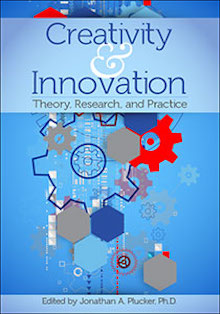Fostering Creativity and Innovation in Class
Creativity and Innovation: Theory, Research, and Practice
Edited by Jonathan A. Plucker, Ph.D.
(Prufrock Press, 2017 – Learn more)

As a teacher who is interested enough in creativity to have read multiple books on the subject and who explicitly teaches her students about creativity and how to spark their creative vibes, Creativity and Innovation: Theory, Research, and Practice immediately appealed to me and I wasn’t disappointed.

Each chapter is authored by a different professional from a wide variety of fields. Reading their bios alone provides valuable food for thought regarding the topic of creativity and presents even more opportunities for research. I was delighted to note that two of the authors are professors in the Dallas/Fort Worth area who will receive emails from me with queries about planning a field trip for my 5th graders to their campuses to meet them and learn more about creativity from their perspective.
Defining creativity
The first two chapters delve into the different definitions and theories of creativity. The consensus is that creativity is a product or idea that is novel and useful in a social context, and the other authors utilize this definition in future chapters.
This definition challenges me to rethink how I teach creativity because I often celebrate my students’ creative ideas that are low on the usefulness scale. Do I continue my current practice or am I doing them a disservice by not also encouraging usefulness as a necessary component of creativity? I’m not sure!
The authors also distinguish creativity, which involves generating an idea, and innovation, which involves implementing an idea. Since I have used these concepts interchangeably, this distinction is particularly helpful.
Another helpful distinction is the difference in Big-C creativity (famous artists or inventors) and little-c creativity (everyday creativity we see in our classrooms). I plan to share this distinction with my own students and even create a continuum in our classroom where we can post examples to extend this conversation.
Theories of creativity
Chapter two takes a deep dive into the different theories of creativity and covers (in detail) these topics: who is creative, how we’re creative, why we’re creative, and what is creative. The book also includes sections covering “Hot Topics” such as the dark side of creativity, which poses questions about the moral spectrum of divergent ideas, the cultural influences on creativity, and the unintended consequences of creative ideas. The discussion ends with the theory that the creative process is amoral and it can be used for both moral and immoral ends.
Once again, I plan to invite my 5th graders into this conversation as a way to deepen our understanding of the real-world application of creativity. Other hot topics later in the book include creativity and intelligence, creativity and mental illness, creativity assessment, creativity and conformity, and creative leisure. Any one of these topics would provide the basis for an interesting discussion or even debate in a middle school classroom.
Fostering creativity
The next several chapters tackle the products of our creative efforts, the different environments that foster creativity, and creativity’s relationship to critical thinking.
Chapter three focuses on creative products and includes a discussion of design thinking. It also provides different ways to assess creative products. Chapter four has more of a business slant with its discussion of how different parts of the country and different businesses foster creativity. As a teacher, my two big takeaways are that I need to create a classroom culture that encourages and values risk and that both the physical space and the atmosphere play a huge role in encouraging creativity.
Chapter five discusses creativity and its relationship to critical thinking and reaffirms my commitment to spending more time explicitly teaching critical thinking skills. This chapter also includes a very interesting discussion about the “conformity effect” and the downside of providing models for our students and asking them to rely on previous experiences and knowledge as inspiration (something I suggest quite often).
The advice for walking this tightrope includes encouraging students to use prior knowledge that isn’t related to the current topic in an effort to encourage combining disparate ideas. The authors also suggest having students create analogies to help them visualize how seemingly different concepts might be related.
Lifetimes of creativity
The next few chapters include the long view of creative efforts over a lifetime, how pretend play influences creativity, how we communicate our creative ideas, and what motivates us to be creative. Chapter six presents different trajectories for careers exhibiting creativity and chapter seven focuses on the role of pretend play in encouraging creativity. Both chapters are interesting but do not have as much practical application for the middle school classroom as other chapters provide.
Chapter eight focuses on creative articulation and challenges teachers to equip students with the skills needed to explain their ideas and convince others of their usefulness and the art of providing and receiving constructive criticism. Chapter nine focuses on internal and external motivations for being creative and references Carol Dweck’s theories about fixed mindset versus growth mindset. It ends with familiar suggestions for teachers, including breaking down projects into tasks, room for student choice in assignments, and teachers sharing their own passions with their students.
The final chapters of the book view creativity through the lenses of personality types, business, leadership, and technology. Chapter ten focuses on different types of personalities and dispositions that are more likely to engage in creative thinking. This information helps me understand why some students may need more encouragement as creative thinkers, but it also raises questions about the nature of creativity and if creativity can also impact personality.
How your classroom can support creativity
Chapter eleven makes the case for including creativity in our schools, an easy sell for me. Chapter twelve’s title is “Creativity in Business,” but don’t overlook this chapter because it contains numerous ideas that teachers can apply in the classroom, especially about the pitfalls of group brainstorming sessions, and it includes some powerful real-world examples to share with our students.
Chapter thirteen provides specific guidance for teachers as leaders (both inside and outside of the classroom) and how we can better facilitate collaboration. It also makes the case for valuing functional diversity by grouping people together who have different backgrounds, perspectives, and prior knowledge. I plan to be more transparent with my students when I group them and encourage them to identify and utilize each other’s strengths and experiences.
Chapter fourteen emphasizes the opportunities students have to be creative both with and through technology and clarifies the difference between the two. The author suggests that rather than try to keep up with the latest technology, teachers instead should teach students how to adapt to these changes. He also uses the metaphor of a swimming pool where the teacher is the swim coach and the lifeguard when it comes to technology in the classroom.
I definitely recommend this book for teachers and administrators who want to extend their understanding of creativity beyond the surface level and who want to rethink how their schools can better support their students as creative thinkers and create an atmosphere that actively promotes creativity in action. I know this will be one of those books that I refer back to as I plan my activities during the school year.
Claire Reddig currently teaches middle school English at The Oakridge School in Arlington, Texas. She has also taught high school English and coached debate and Destination Imagination teams. Her passions include sparking students’ creativity while challenging them to develop their critical thinking skills and incorporating MakerSpace and Design Thinking elements into the Language Arts classroom. She has presented at professional conferences including TCTELA and LLI SW and LLI MS, and she shares her ideas on her blog, Maker Inspired Writing.






























